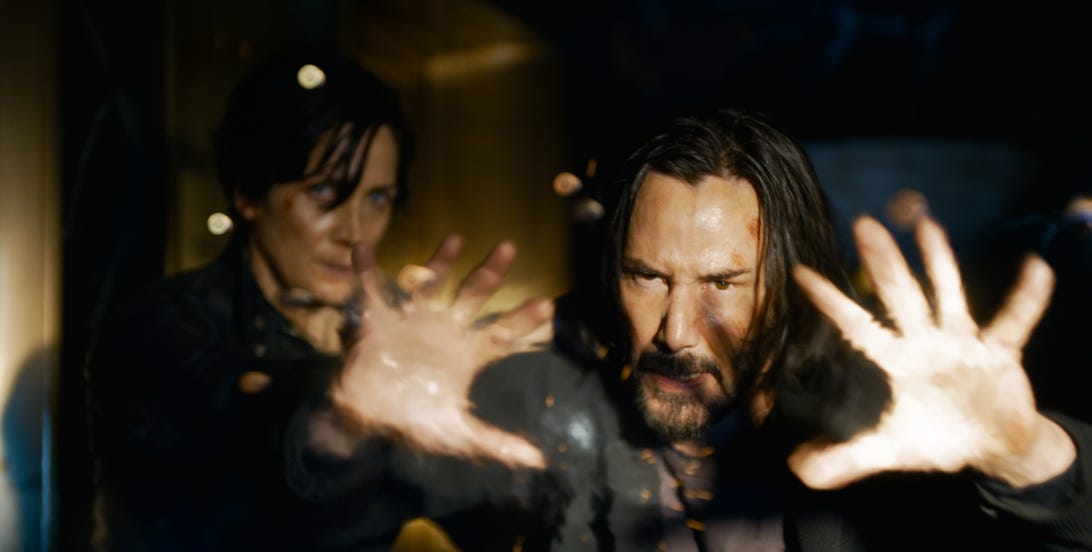
Carrie-Anne Moss and Keanu Reeves share some bullet time in The Matrix Resurrections.
Warner BrosIt’s been 20 years and people just will not shut up about The Matrix. You might expect slick remix The Matrix Resurrections to be just money-grabbing nostalgia, but it’s also a comment on money-grabbing nostalgia, a refinement and updating of the original film’s ideas, and an exasperated clap back to anyone who missed the damn point these past two decades.
With guns. Lots of guns. And even a few jokes.
The Matrix Resurrections is available to rent and buy online now after a muted release in theaters and on streaming service HBO Max. The 4K UHD, Blu-ray and DVD release will follow March 8. This visually arresting sci-fi flick arrived over a holiday period tainted by the omicron variant, not to mention the opportunity to stream at home. Despite the box office performance, however, this oddball sequel is well worth a look, even if it won’t be at all what you expect.
Keanu Reeves returns as Thomas Anderson, a computer geek living an unfulfilled life and haunted by the idea maybe nothing is real. Strange signs and portents keep showing up in his life, forcing him to make a choice whether to step out of the numbing safety of mundanity or seek a dangerous uncharted path involving something called… The Matrix.
You read that right: The Matrix 4 is very much a reset to the beginning of the series, not just harking back to the first film but reliving and remixing it, turning it upside down and poking at what’s inside. Original writer and director Lana Wachowski returns to the world she created with sibling Lilly Wachowski (who isn’t involved this time), and the new film feels almost like a director’s commentary on the original. The original films already played with layers of reality in a post-modern, self-reflexive way, and Resurrections doubles down with layer upon layer of meta self-awareness — in fact, comparing it to a director’s commentary actually feels too old-timey, too analogue: Resurrections is more like a re-recording and remix of a classic album, in space.
Funnily enough, Resurrections is the second blockbuster sequel this year with a title and subject matter resurrecting an apparently dead film series. Like Ghostbusters: Afterlife, this new Matrix film explicitly addresses its own legacy, as the original real-life thing is also a thing in the story, so the film’s characters are fans of the original thing, just like the viewer. The silver screen is a mirror.
In Afterlife, that translated as fan-pleasing tributes which squashed a promising new direction under the weight of gratuitous nostalgia. But in Resurrections, Wachowski refuses to pander to the film’s fans. In fact, Resurrections addresses the many and varied ways the original film has been adopted or co-opted. It pokes fun at over-earnest assertions that the film’s symbolism and metaphors mean this or that, and exasperatedly rolls its eyes at those who’ve “missed the point” of the infamous red pill.
Remember: All I’m offering is the truth.
Warner BrosAs a jaded and middle-age Neo suffers from being surrounded by people who can’t stop talking at him about what The Matrix really means, the opening scenes of the film play out what life must have been like these past two decades for Reeves, and particularly for the Wachowskis. If you’ve ever gone back to one of your favorite films from your youth and found it startlingly different seen through older (and hopefully wiser) eyes, you’ll understand what Lana Wachowski must be going through. The first half of Resurrection is less trippy sci-fi questions about simulations and simulacra, and more a jittery dissection of art under capitalism. A musing on the artistic recidivism of resurrecting that one lucrative artwork people keep talking about, even if you don’t want to. A barbed treatise on the quandary of shoveling content into the voraciously chomping nostalgia-harvester of the digital age.
But, y’know, funny.
This isn’t me overthinking some wacky subtextual interpretation, by the way — the film is literally about Keanu/Anderson being forced to make a literal, actual Matrix sequel by literal, actual Warner Bros. Evoking the famous sad Keanu meme, Anderson suffers in silence while Matrix nerds yell at him. These early scenes are a candid portrait of an artist struggling with the agony and anxiety of success, like 8 1/2 with more shootouts.
Keanu watches The Matrix.
Warner BrosSpeaking of shootouts, one of the big reasons the ’90s Matrix was such a game-changer was its jaw-dropping action. On the cusp of the CG revolution and blowing everyone’s minds with that innovative bullet time effect, those unforgettably iconic action scenes kicked in the door so the Wachowskis could lob in so many big ideas.
That puts a lot of pressure on this film to come up with something new and gobsmacking. Again, that’s part of the film, as character actually discuss how they can top bullet time’s cultural impact. Self-mockingly highlighting a problem doesn’t solve it, however, and there isn’t anything as groundbreaking or even as exciting as the first film. In fact, in the age of CG, even the recreations of the signature gravity-defying Matrix mayhem feel a bit weightless. Later sections of the film feature a digital effect, which is probably exceedingly clever but just looks like a leftover from the recent Terminator movies.
The effects may not be game-changing, but there’s still room for the punching and kicking to kick your heart into your mouth. The climax, for example, features one macabre moment impacting with a horrifying idea rather than flashy CG. And yet the fights offer surprisingly inert staging and static camerawork. Sure, it’s nice to actually see and follow what’s going on in punch-ups that are clearer than the incomprehensible shaky-cam and whiplash-inducing editing that ruins all too many action scenes lately. But several of the fight scenes are essentially re-creations of the original, only without as much energy or even a sense of what’s at stake. You get the feeling Wachowski just isn’t interested in the banging and crashing any more.
Rather, Resurrections seems to be interested in honing the original films’ ideas instead of heading in bold new directions. By the end of the sequels (Reloaded and Revolutions) the series bogged down in ponderous philosophizing, but Resurrections is pleasingly light on its feet in comparison. You don’t have to remember any of the sequels’ tortuous lore, happily (although once again, anything in the shaved-head-and-chunky-knitwear real world drags on forever).
While there’s quite a lot of standing around talking, the new faces bring a nimble zest to proceedings. In the absence of Laurence Fishburne, Morpheus is reincarnated with youthful swagger and eye-popping tailoring by the absurdly watchable (and under-used) Yahya Abdul-Mateen II. Meanwhile, black-suited bad guy Agent Smith is reinvented as a blankly sociopathic/narcissistic tech bro type in the shape of Jonathan Groff. Neil Patrick Harris and Jessica Henwick are also fun to watch. And watch out for old face Lambert Wilson in perhaps the most hilariously socially distanced cameo the pandemic will throw up.
But it’s in Keanu’s other original co-star, Carrie-Anne Moss, that the film finds its focus. Trinity is now living the life of a wife and mother, a traditional feminine role chafing against her essential inner self ground down by society’s rules and expectations. That’s clearly a story about which Lana Wachowski had more to say (both Wachowski siblings are transgender women), and it also gives the film a heartbreaking dramatic punch. I found myself less interested in some technical explanation of how the new Matrix worked, instead aching for Neo and Trinity to figure it out together.
As the original trilogy expanded, Resurrections shrinks down tight to essentially a love story. The further it gets from that driving motivation, the middle of the film wobbles off course without a clear sense of direction, threat or urgency. So by the end you’ll surely be rooting for Neo and Trinity, that perfect big screen pairing, to kick the Matrix’s ass again.
And then maybe people will shut up about it. But probably not.


